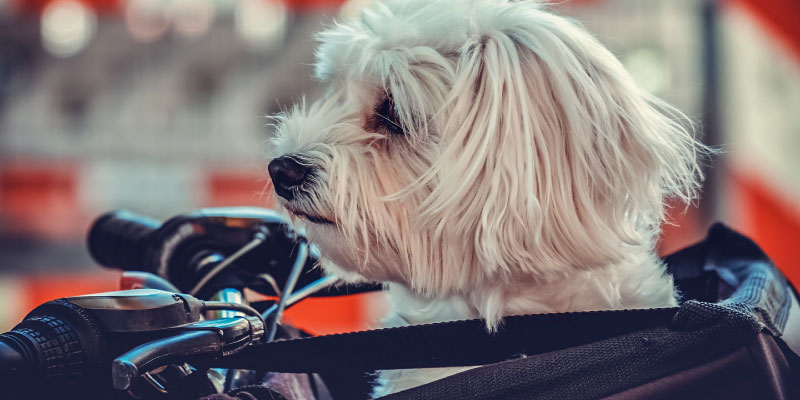If you’re looking for a fun, fresh new way to exercise, cycling is a great place to start. Not only does it increase lung capacity and cardiovascular fitness, it’s also lower impact than other sports like running – great for those with injuries.
And whilst no all dog breeds will be suited to this activity, there’s no reason why many of man’s best friends can’t join you along for the ride.

There are multiple benefits to exercising with your dog, including:
- Improving the bond between the two of you
- Motivating you to get out and improve your fitness
- Keeping your dog active and strong
- Letting your dog explore its natural habitat – the outside world.
Of course, getting on the saddle is slightly different from your standard walk. If you’re not sure where to start, check out our tips on how to cycle with your dog.
First things first: is cycling with a dog cruel?
Before we tackle this, it’s important to distinguish whether we mean cycling with your dog running beside you, or carrying your dog.
Strictly speaking, there’s no reason why cycling with your dog running beside you should be considered cruel. You will just have to consider your dog’s health in the same way that you do when you’re out walking, but to further extremes.
Whilst you should always check the specific needs of your breed (if in doubt, ask your Vet), we would say as a general rule of thumb that cycling with your dog is an activity generally reserved for dogs of medium to larger sizes.
The good news is that, as with human, you can build up their stamina and fitness level, as well as have equipment that can help with longer rides.
Rule no. 1: consider your speed
For example, the average beginner’s cycling speed is 12mph. Compared to the average human walking speed, 3mph, that’s quite a hike. If you want to go further than very short distances, there’s no way you’ll be able to maintain this speed without causing harm to your dog.
Most dogs can run between 15 to 20mph, but for short distances only. There are multiple factors that affect this, from breed to age and general fitness. For this reason, you should minimise your speed to match a dog’s leisurely jog. There are also the safety concerns of going too fast through public places.
Mountain biking and off-road cycling is probably the best place to start. You have to go slow through difficult areas, and your dog can keep up.
Rule no. 2: check the weather
The same applies with cycling here as it does to walks and runs. If you’re venturing out on a hot day, check the ground first.
When it feels hot to the touch and makes you flinch, you should not walk your dog. You could risk dehydrating your pup, particularly for more strenuous exercise like cycling.
Similarly, too cold and you could run the risk of cycling over black ice. Try to aim for spring days or summer mornings/evenings to stay safe.
Rule no. 3: consider your environment
Again, this applies to runners and walkers too, but you’ll have to react much quicker on a bike.
Try to plan your cycling route before you go out – take a walk along it to make sure there aren’t any hazards, difficult areas and any real dangers for you and your dog.
Try to avoid especially crowded areas, too, for example parks during school holidays.
Rule no. 4: get your dog cycle kit ready
This is for those who are planning to pedal with their dog running beside them. If you want to cycle while carrying your dog, you can find our other dog biking tips below. Firstly, cycling with a dog on a lead is essential for safety.
You can buy custom-made bike leashes that attach to your bike rather than letting you hold the lead up by the handlebars. These are essential for keeping your dog away from the wheels.
If you want to bike with your dog in low light, consider a reflective dog harness or reflective tape. You should also use blinking lights on both your bike and your dog’s collar.
Finally, don’t forget the essential water bottles, and a first aid kit if you’re going the distance. You should also carry an extra leash if you’re planning on dismounting and going for a wander.
Rule no. 5: check if your dog is ready
Now that you’re all ready to go, is your dog ready? You may want to check with your vet before starting out on a new exercise routine. Your vet will be able to advise you what’s best based on your dog’s age and general health.
For example, dogs younger than 18 months may not have fully developed bones yet. If your dog isn’t able to run 5K with you without panting and struggling, it’s unlikely he will be able to do half that distance on a bike.
Likewise, if your dog is overweight, you should start with light walks first, while smaller breeds may struggle more than larger ones.
So, what if you are biking with a small dog? Is there an alternative?
Bike riding with your dog as a passenger
Perhaps yours is a smaller breed, a young pup or simply not cut out for strenuous exercise. Enter, the dog wagon for bikes!
These come in two forms – for smaller pups, they can be a modern take on the classic basket. You can attach these behind the seat on a rack, or on your handlebars, depending on the size.
Make sure you only buy a basket that has a harness or leash attachment to stop your dog from jumping out. Trial it around the block once or twice before you commit to longer journeys. This may startle your pup if it’s an entirely new experience!
Dog bike trailer larger dogs
If you’re not worried about speed, you can also try a big dog bike trailer. Think of this as a motorbike sidecar – it’s your own wagon that’s capable of transporting larger dogs.
These are usually for breeds that weigh 20lb or more. The best dog bike trailer will come with suspension, a lightweight frame like aluminium, and an anti-slip floor to make your dog more comfortable. You may also want to consider a blanket.
The good news is this is a great accessories to have by your side on long rides – your pup can jump out when it’s safe, and if he is trained to ride along with you, and if he gets tired he can jump into the trailer.
Biking with a small dog in your backpack
They’re not just accessories to carry in handbags. Smaller dogs can now travel with you on your bike in their very own specially made dog carrier backpack! You can get your dog used to the backpack by carrying it around the house. These keep your dogs safe and secure while allowing for movement.
For best results, make sure they are sitting upright with their legs and head out. Make sure you’re comfortable, too – you should be able to keep your back straight without straining. If they’re too heavy, it might be time to consider the bike basket or the dog bike trailer.
Looking for a more hardcore ride? How to bike with your dog in other settings
Perhaps you want to battle the elements or even try mountain biking with your dog. You’ll need to make sure you’ve equipped yourself properly – for example, in cooler weather, your dog may need boots of its own.
Some breeds are better suited for extreme bike rides than others. For example, the Border Collie or Labrador has boundless energy and loves getting out and about in trail environments. You’ll never get a French bulldog to go beyond 5 meters before they ask to go back into the backpack.
Whatever you decide to do, you do need to ease your dog in slowly. Get them used to the new environment with leisurely walks. You should also bring your bike on these walks to get your dog used to the sight of it. Try it over a period of one to two weeks.
In these ‘trail’ scenarios, you will be less likely to use a leash, so ensure your dog has mastered responding to your calls. You can trial this by walking the dog while riding a bike in the safe and quiet park, or a small woodland trail.
Above all, go slow
Any change to a dog’s routine may be hard to get accustomed to at first. Whatever kind of bike riding you’re doing, make sure you introduce your pup at a slow pace.
Chances are, this is an activity you’ll be looking to do once a week together to begin with, maybe twice a week with most but the most active breeds.
Your pup will need rest in between cycling session, so take it easy. The wonderful thing about dogs is that they love to please, and will push themselves far beyond they should in order to keep you happy. Be responsible and move slow. It’s your responsibility to read your dog needs and health.
That said, especially with the most active breed where energy is not a problem, cycling with your dog can be a great way to get your pup happy, healthy and active. Pretty soon, it could be your favourite activity to do together.
Looking for a few other ways to spend quality time with your pup? Take a look at our list of dog adventures.




